Contact Robb Hammond for more information.
It has become necessary for all distributors of electronic components and manufacturers of electronic equipment to inspect all incoming electronic components for authenticity. This document has been derived from years of inspections at our facility and recent involvement in industry committees and symposiums related to the increase in counterfeit electronic parts activity. Our goal with this document is to inform you how to detect counterfeit parts and be confident in your evaluation.
Counterfeit electronic components are most prevalent in mainland China. Although we do not purchase from unauthorized distributors directly from that region, we continue to receive counterfeit parts on a weekly basis. Often the counterfeits supplied to us are from long time, good standing suppliers who are just not trained or prepared at avoiding counterfeit electronic components.
We will start with the most simple necessary tools to detect counterfeit integrated circuits. You will need all of the standard tools for handling electrostatic sensitive parts. For the detection of counterfeit parts you will also need a microscope with at least 30X magnification. It is also important that you have a camera built into your microscope. Some of the processes of counterfeit electronics detection require you to send copies of photos to different resources for their evaluation. In addition to a microscope you will need a solvent to check for part marking permanence. Acetone is a common chemical to determine if the part has been remarked, but a less harsh solvent is a combination of 3 parts mineral spirits and one part alcohol. This is the mixture that MIL-STD-883 (method 2015.13) requires part markings to withstand.
To begin avoiding counterfeit electronic components we start with a visual inspection of all of the packaging. Some of the signs to look for are:
- Misspellings on the manufacturers labels
- Verification that the date code on the label match dates codes on the parts
- Date codes that are not possible. ex. 0657
- Date codes that are in the future
- If parts are moisture sensitive they require a dry pack and a Humidity indicator card. Often the counterfeiters forget some piece of the moisture sensitive parts requirements. Part specific requirements can usually be found on the datasheet.
Examination of the Indents
Most plastic integrated circuits have cavities purposefully made during the mold process. Some of them are pin one or other designations for use in part placement, but others are just part of the plastic mold process. Mold cavities should be clean, according to the manufacturers we have spoken to. Examining these indents is our number one way of detecting counterfeit components. The counterfeiters have a very difficult time keeping the indents clean and consistent during their refinishing process. The pictures to follow are examples of what we have received in our warehouse and a small explanation of our observation follows.
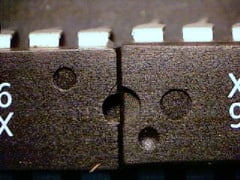 These two parts were received in the same lot and have identical part number markings. These are the same ends next to each other and you can see that one has 3 indents and the other has just 2. The shape and size of the indents are also different. One is a rounded cavity and the others are all flattened.
These two parts were received in the same lot and have identical part number markings. These are the same ends next to each other and you can see that one has 3 indents and the other has just 2. The shape and size of the indents are also different. One is a rounded cavity and the others are all flattened.
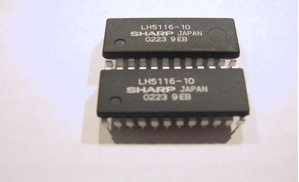 Again you can see differences in the indents. The indent to the lower left looks similar, but the middle right indent is not apparent on the bottom part. This seems to occur because the counterfeiters sand down the parts to remove the old markings and then they resurface it with a process called “blacktopping”, which often fills shallow cavities.
Again you can see differences in the indents. The indent to the lower left looks similar, but the middle right indent is not apparent on the bottom part. This seems to occur because the counterfeiters sand down the parts to remove the old markings and then they resurface it with a process called “blacktopping”, which often fills shallow cavities.
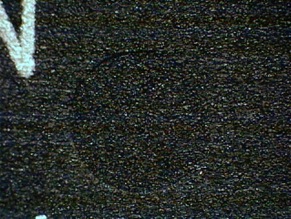 Here is a close up of an indent that has been filled in with the “blacktopping” material. These indents are never partially made during the manufacturing process. They are uniform in depth throughout the circle. This particular one is filled to the edge on one side.
Here is a close up of an indent that has been filled in with the “blacktopping” material. These indents are never partially made during the manufacturing process. They are uniform in depth throughout the circle. This particular one is filled to the edge on one side.
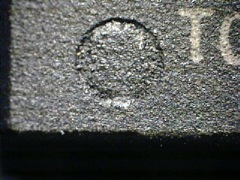 The indents are always clean and uniform from the manufacturer. This indent has been filled in with the materials used to cover up the old surface.
The indents are always clean and uniform from the manufacturer. This indent has been filled in with the materials used to cover up the old surface.
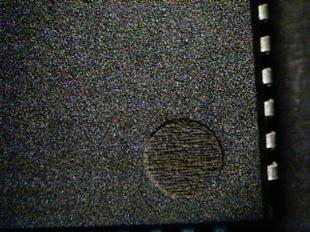 The counterfeiters are slowly figuring out that we are catching their mistakes. We have started to see an attempt to visually add an indent so all of the parts look uniform. From a naked eye this indent looks like a regular indent. With the microscope it is easy to see that they have etched a circle to create the appearance of a normal indent.
The counterfeiters are slowly figuring out that we are catching their mistakes. We have started to see an attempt to visually add an indent so all of the parts look uniform. From a naked eye this indent looks like a regular indent. With the microscope it is easy to see that they have etched a circle to create the appearance of a normal indent.
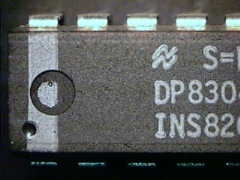 We are assured by the manufacturers that we speak with that they are very strict with their standards when manufacturing parts. Paint in the indents is not where it is intended, therefore it is suspect counterfeit.
We are assured by the manufacturers that we speak with that they are very strict with their standards when manufacturing parts. Paint in the indents is not where it is intended, therefore it is suspect counterfeit.
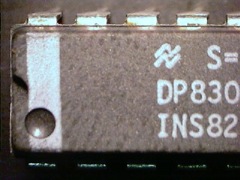 This part is from the same lot code as the above part. You can see an additional problem with the differences in indents. One is much larger and another is non existent. If there is no “smoking gun” we are looking for more than one clue to make our final determination that the parts are counterfeits. In this case we have two fairly obvious anomalies which make our determination clear.
This part is from the same lot code as the above part. You can see an additional problem with the differences in indents. One is much larger and another is non existent. If there is no “smoking gun” we are looking for more than one clue to make our final determination that the parts are counterfeits. In this case we have two fairly obvious anomalies which make our determination clear.
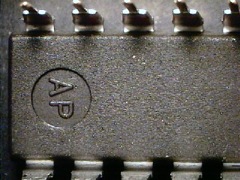
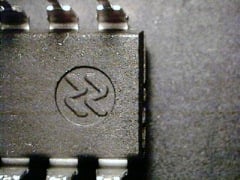
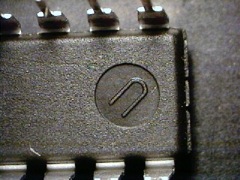
These 3 parts are all marked identically on the top. The indents of these 3 have completely different markings. Not only are they different, but they do not follow any pattern. It is not uncommon on legitimate parts to see similar patterns that are not identical. For example, it can be a legitimate part if you had product, that like the first one had 2 letters in the indents, but they were different letters. It could have “”BP” on another part and not be a threat of counterfeit material. It is the same with the 3rd picture. You may have a “T” on another part without cause to worry.
Countries of Origin
Most parts, which are large enough to write a country of origin, display where it was manufactured somewhere on the part. It is commonly placed in the indents, but it can be written anywhere on the part. Smaller parts often have codes within the lot codes for country of origin information, which makes it difficult to use as a deciding factor. We have done investigations with the component manufacturers and all of them we have spoken to say that a part with the same lot code as another cannot be manufactured in different countries. See the pictures to follow for examples.
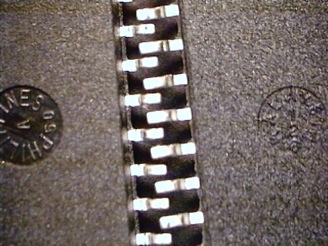 It is difficult to see the marking on the right because the blacktopping has made the writing unclear, but it is marked “MALAYSIA” and the part on the left with the same top markings is marked “PHILIPPINES”. We will show close up pictures of the blacktopping problem on the right in the “Texture” section because this is a good sign of counterfeits as well.
It is difficult to see the marking on the right because the blacktopping has made the writing unclear, but it is marked “MALAYSIA” and the part on the left with the same top markings is marked “PHILIPPINES”. We will show close up pictures of the blacktopping problem on the right in the “Texture” section because this is a good sign of counterfeits as well.
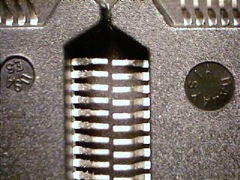 Same lot code on top. Manufactured in separate countries.
Same lot code on top. Manufactured in separate countries.
Texture
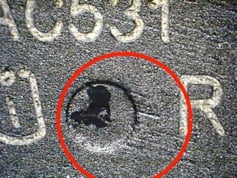
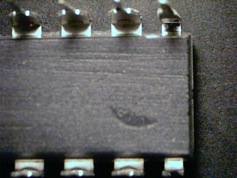
On the above 2 pictures I want to focus on the directional sanding marks. Parts coming straight out of a mold will not have any marks the have a directional pattern. These types of marks are made when the counterfeiters are sanding off the top or bottom markings to prepare the part for blacktopping. Again, you must have a microscope to see this type of inconsistency. It is not visible with the human eye.
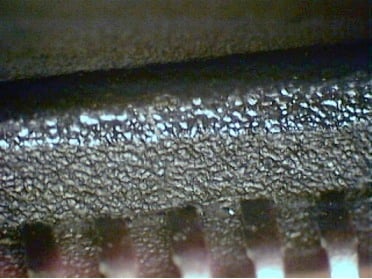 Often if you look at the edge of the parts you can see the change in texture from the blacktopping. See how the top of the part is shiny and the bottom has a duller finish. Don’t forget these parts are made in a mold. And these molds are not designed to put a beautiful shiny finish on the top so they can sell their good looks. The texture should not change halfway on a section of the part. This picture is a great example of an original vs. the fake finish. If they do a really good job and there are no flaws it makes it very difficult to detect, but you can usually find a few flaws, as detailed throughout this document, since all of this work is done by hand. Then you can use evidence like this to help you close your case.
Often if you look at the edge of the parts you can see the change in texture from the blacktopping. See how the top of the part is shiny and the bottom has a duller finish. Don’t forget these parts are made in a mold. And these molds are not designed to put a beautiful shiny finish on the top so they can sell their good looks. The texture should not change halfway on a section of the part. This picture is a great example of an original vs. the fake finish. If they do a really good job and there are no flaws it makes it very difficult to detect, but you can usually find a few flaws, as detailed throughout this document, since all of this work is done by hand. Then you can use evidence like this to help you close your case.
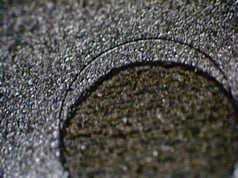 The more samples you see you should start to be able to see the difference between an original surface and a fake one. The glare on the main surface tells us that there is a high possibility of blacktopping. The fine glass and plastic that the molds are generally produced with do not shine like this part. This is another indent created to visually fool those who are relying on their naked eye for inspection. The error that they made creating this circle is visible and the texture inside of the circle is neither smooth nor similar to the rest of the part.
The more samples you see you should start to be able to see the difference between an original surface and a fake one. The glare on the main surface tells us that there is a high possibility of blacktopping. The fine glass and plastic that the molds are generally produced with do not shine like this part. This is another indent created to visually fool those who are relying on their naked eye for inspection. The error that they made creating this circle is visible and the texture inside of the circle is neither smooth nor similar to the rest of the part.
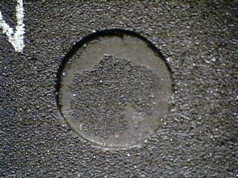 This picture shows that there are 2 different textures in one area. It is not uncommon to see a smooth finish in the indent and textured on the face of the part, but never should you see 2 different textures on one area of the part.
This picture shows that there are 2 different textures in one area. It is not uncommon to see a smooth finish in the indent and textured on the face of the part, but never should you see 2 different textures on one area of the part.
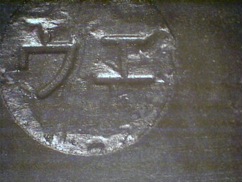 Remember, the indents should be clean. The reason that they are not uniform here is because during their remarking process the materials get stuck in the indents. Any extra material in the indents does not belong there.
Remember, the indents should be clean. The reason that they are not uniform here is because during their remarking process the materials get stuck in the indents. Any extra material in the indents does not belong there.
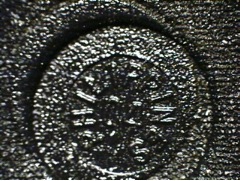 This is a similar example, but here you can see that they have attempted to re-stamp over the existing stamp. Most likely they did this to cover up different countries of origin.
This is a similar example, but here you can see that they have attempted to re-stamp over the existing stamp. Most likely they did this to cover up different countries of origin.
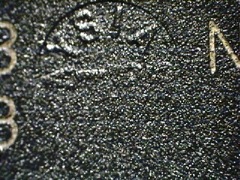 As previously described, the indents are typically smooth and therefore the writing within them should not be textured either. This is an extreme example because half of the indent is filled by the blacktopping material, but if you see letters with texture on them it is most likely blacktopped.
As previously described, the indents are typically smooth and therefore the writing within them should not be textured either. This is an extreme example because half of the indent is filled by the blacktopping material, but if you see letters with texture on them it is most likely blacktopped.
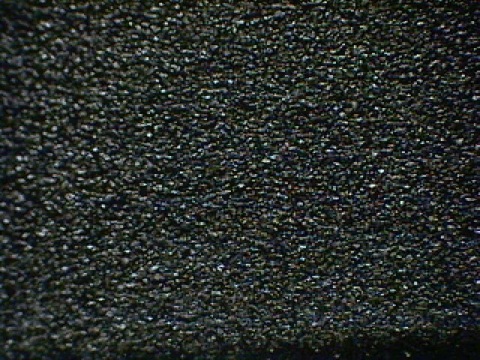
This is a close up of how the surface of the part should look. It is very hard to see in pictures, but through a microscope the differences between a typical fake and an authentic part can best be described as; the surface of a true part has a sharper and duller look. The glass in the mixture makes for sharp little peaks and valleys, whereas, when painted with the blacktopping material the peaks and valleys are smoothed over and filled in, like if you were to put a coat of paint on sand paper. This picture and description are not relevant to every part, but the majorities have this type of finish. There are some legitimate parts that have smooth plastic finishes that must not have glass in the mixture.
Plastic Electronic Components are typically made with a mix of fine glass and plastic. The surface of the molded package is textured when it is removed from the mold. The pin cavities are often very smooth as you can see in the previous picture. The counterfeiters have come up with a very good mixture to create a very similar surface on top of the original surface. With the naked eye it is almost impossible to determine the difference between the original surface and a fake surface. By taking a close look through the microscope there are many signs that can help you determine the authenticity of a component. See the pictures to follow for examples.
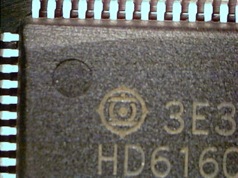 On the top left hand side of this part the sander went a little too far. You can see that they have made an angle sloping downwards which none of the other parts in this lot had. This is uncommon, although it is common to see an edge slightly rounded. You can see this when looking through the microscope, but it is hard to show in a 2 dimensional photograph.
On the top left hand side of this part the sander went a little too far. You can see that they have made an angle sloping downwards which none of the other parts in this lot had. This is uncommon, although it is common to see an edge slightly rounded. You can see this when looking through the microscope, but it is hard to show in a 2 dimensional photograph.
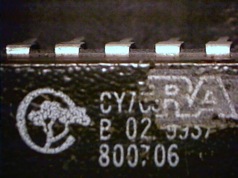 This is one of our most amazing discoveries. This very shiny, smooth, but orange peel type finish was not natural looking. You need to start to be able to tell an authentic texture from a fake. This one made it a bit easier because it was so different. We decided to try to scrape the thick looking blacktop off and we found this Altera logo under the Cypress marking.
This is one of our most amazing discoveries. This very shiny, smooth, but orange peel type finish was not natural looking. You need to start to be able to tell an authentic texture from a fake. This one made it a bit easier because it was so different. We decided to try to scrape the thick looking blacktop off and we found this Altera logo under the Cypress marking.
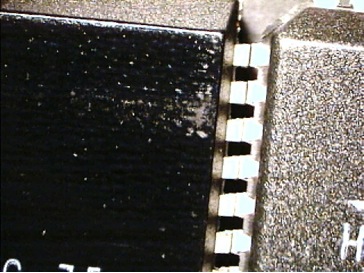 Here is another part with the blatant blacktopping. The one to the right has the exact same lot code on it. The one to the right is also a legitimate surface. This is a very interesting case to note. We reported this to our supplier who we knew primarily purchases their parts from the original manufacturer’s obsolescent excess products. Upon further investigation we found that the part to the left was actually resurfaced by someone for the manufacturer. If a part is mis-marked at the factory or they want to upgrade or downgrade a part, that is capable of doing so, they may re-mark their parts. I understand this is very rare, but it does happen.
Here is another part with the blatant blacktopping. The one to the right has the exact same lot code on it. The one to the right is also a legitimate surface. This is a very interesting case to note. We reported this to our supplier who we knew primarily purchases their parts from the original manufacturer’s obsolescent excess products. Upon further investigation we found that the part to the left was actually resurfaced by someone for the manufacturer. If a part is mis-marked at the factory or they want to upgrade or downgrade a part, that is capable of doing so, they may re-mark their parts. I understand this is very rare, but it does happen.
Resistance to Solvents
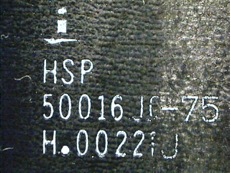 In the beginning of this document we mentioned a solution to check for marking permanence. This part is the same as the previous picture after an acetone wash on the right hand side. It is very obvious that there was some sort of a top coat on top of the molded plastic. If you wash the part with one of the suggested solutions and you see a different texture or the marking wipes off you can be fairly certain you have a counterfeit.
In the beginning of this document we mentioned a solution to check for marking permanence. This part is the same as the previous picture after an acetone wash on the right hand side. It is very obvious that there was some sort of a top coat on top of the molded plastic. If you wash the part with one of the suggested solutions and you see a different texture or the marking wipes off you can be fairly certain you have a counterfeit.
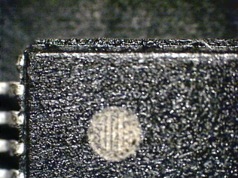 BEFORE: This is a before picture of a part we suspected of being counterfeit. See the textured, but shiny black finish?
BEFORE: This is a before picture of a part we suspected of being counterfeit. See the textured, but shiny black finish?
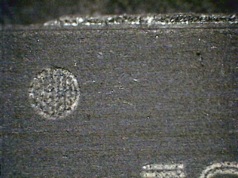 AFTER: This is the same part after being washed with acetone. You can see some light sanding marks, but this looks more like an original surface of a legitimate part.
AFTER: This is the same part after being washed with acetone. You can see some light sanding marks, but this looks more like an original surface of a legitimate part.
Imperfections
All of the manufactures, which we have spoken to, state that they have high quality standards which preclude them from major imperfections. The part numbers are to be in a certain location on the part and they are not to be crooked, misspelled, or out of alignment. The logos are also monitored very closely and should not vary from part to part. In addition, the markings are to withstand tough environments and still be legible.
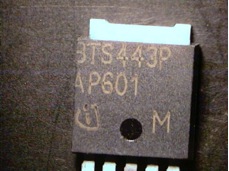 Manufacturers state that the markings should be in a proper area of the part. This batch of parts on a reel had the markings in a little different area on each part. This particular one missed the part on the left hand side.
Manufacturers state that the markings should be in a proper area of the part. This batch of parts on a reel had the markings in a little different area on each part. This particular one missed the part on the left hand side.
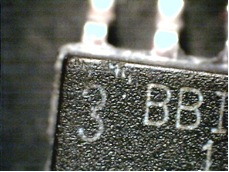 The character in the far left is supposed to be a “B”. We also noticed they have etched some extra marks, towards the top, that are filled with the same color used to display the part number.
The character in the far left is supposed to be a “B”. We also noticed they have etched some extra marks, towards the top, that are filled with the same color used to display the part number.
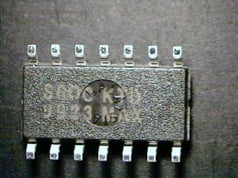 This part is marked on top of the indent, which again the manufacturer has informed us is not acceptable from their production. Maxim informed us that these are counterfeits. We have seen this marking error on more than one occasion.
This part is marked on top of the indent, which again the manufacturer has informed us is not acceptable from their production. Maxim informed us that these are counterfeits. We have seen this marking error on more than one occasion.
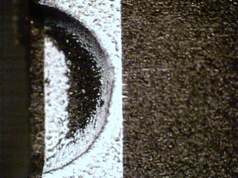 Here again, the marking is not where is should be. The manufacturers will tell you that they do not allow this in their production.
Here again, the marking is not where is should be. The manufacturers will tell you that they do not allow this in their production.
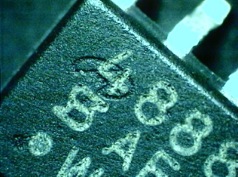 This part was on a manufacturer’s labeled reel of 2500 pieces. The old etched logo is very hard to see with the naked eye, let alone through the foggy tape. We decided to pull some out of the tape because this supplier did not have the best history. The old etching had been blacktopped and etched over again with the new part number.
This part was on a manufacturer’s labeled reel of 2500 pieces. The old etched logo is very hard to see with the naked eye, let alone through the foggy tape. We decided to pull some out of the tape because this supplier did not have the best history. The old etching had been blacktopped and etched over again with the new part number.
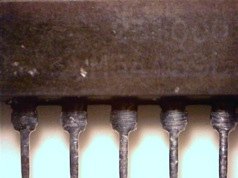 The marking on this part was very crisp and clear. The leads looked a little used, but the markings looked straight out of the manufacturer. The surfaces looked legitimate so the only other visual check we could perform was marking permanency. We used MIL-STD-883 standard 3 parts mineral spirits and one part alcohol and the part number wiped right off.
The marking on this part was very crisp and clear. The leads looked a little used, but the markings looked straight out of the manufacturer. The surfaces looked legitimate so the only other visual check we could perform was marking permanency. We used MIL-STD-883 standard 3 parts mineral spirits and one part alcohol and the part number wiped right off.
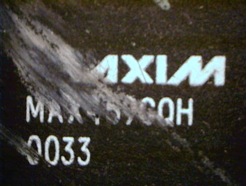 The markings wiped off of this part easily also. One thing to note about Maxim, in particular, is that they have not marked their parts with paint since at least before 2002. They only etch their parts. In this case that did not help us because the parts were made in 2000, but if you receive a Maxim part painted that has a date code newer than 2002 you have a counterfeit.
The markings wiped off of this part easily also. One thing to note about Maxim, in particular, is that they have not marked their parts with paint since at least before 2002. They only etch their parts. In this case that did not help us because the parts were made in 2000, but if you receive a Maxim part painted that has a date code newer than 2002 you have a counterfeit.
Internal Characteristics
The counterfeiters have gotten much better doing their external work, therefore if the parts are for a high reliability application it is important to inspect the internal characteristics of the part. The equipment and personnel to perform the internal testing are much more advanced, therefore more costly. The most important internal evaluations are Decapsulation to see that at least one of the die in the lot is correct, then X-ray inspection of a large sample of the balance of the lot to confirm that the entire lot is all the same.

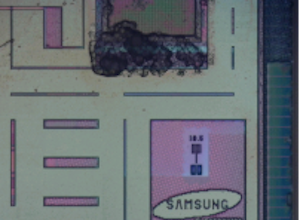
Confirmation of a part through decapsulation.


Suspect counterfeit example X-rays of two parts with the same part number and lot code with different internal characteristics.
Physical Composition
Another helpful process to confirm a parts authenticity is through identifying if the leads are constructed with correct material. Counterfeit parts can be either re-tinned to cover up previous use or constructed with a different material due to the fact that the part is not the actual part as marked. This test is performed by an XRF Analyzer (X-ray fluorescence). Below is an example of a report from our XRF Analyzer which we would compare its results with the manufacturers specifications.

Conclusion
After reading this document in it’s entirety you will have a much better chance of detecting counterfeit electronic components. Counterfeit parts threaten every facet of our industry. It is important that we work together to stop the problem. Please share this document with everyone you do business with in the industry. Feel free to contact me or any of my staff with questions.


